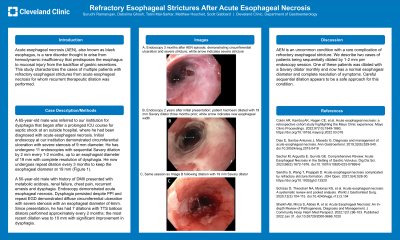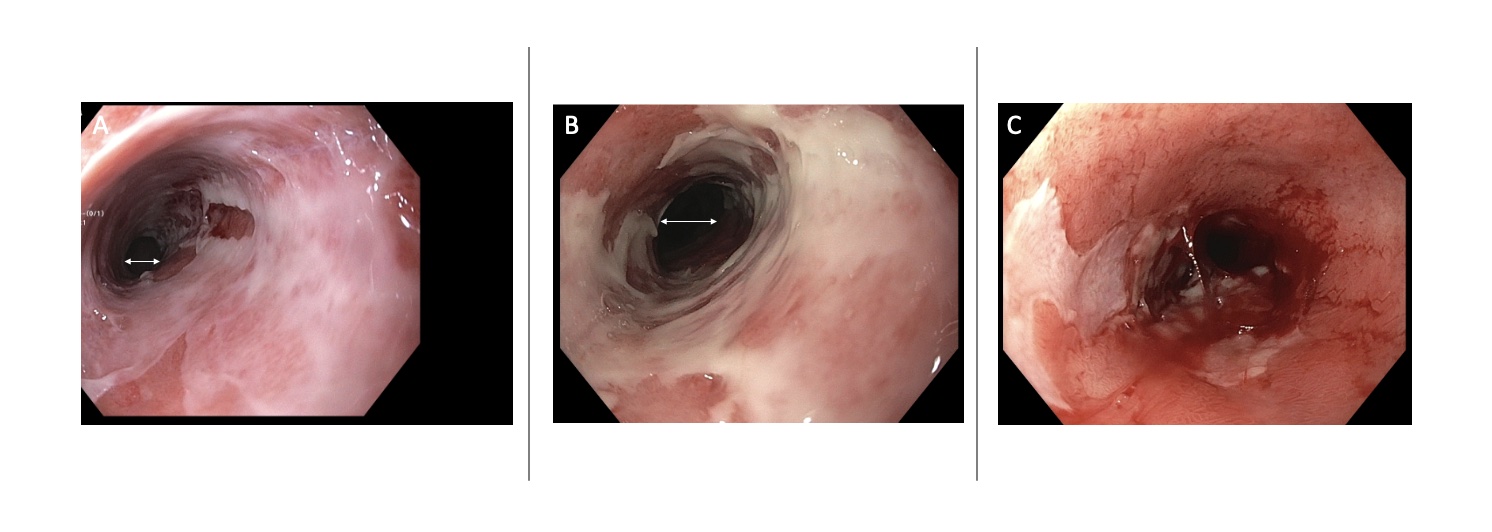Tuesday Poster Session
Category: Esophagus
P3982 - Recurrent Esophageal Dilation in Patients With Refractory Esophageal Strictures
Tuesday, October 29, 2024
10:30 AM - 4:00 PM ET
Location: Exhibit Hall E

Has Audio

Tatini Mal-Sarkar, MPH
Case Western Reserve University School of Medicine
Cleveland, OH
Presenting Author(s)
Suruchi Ramanujan, MD1, Debolina Ghosh, BA2, Tatini Mal-Sarkar, MPH2, Matthew Hoscheit, MD3, Scott Gabbard, MD3
1University of California San Diego, Cleveland, OH; 2Case Western Reserve University School of Medicine, Cleveland, OH; 3Cleveland Clinic Foundation, Cleveland, OH
Introduction: Acute esophageal necrosis (AEN), also known as black esophagus, is a rare disorder thought to arise from hemodynamic insufficiency that predisposes the esophagus to mucosal injury from the backflow of gastric secretions. This study characterizes the cases of multiple patients with refractory esophageal strictures from acute esophageal necrosis for whom recurrent therapeutic dilation was performed.
Case Description/Methods: A 65-year-old male was referred to our institution for dysphagia that began after a prolonged ICU course for septic shock at an outside hospital, where he had been diagnosed with acute esophageal necrosis. Initial endoscopy at our institution demonstrated circumferential ulceration with severe stenosis of 9 mm diameter. He has undergone 11 endoscopies with sequential Savary dilation by 2 mm every 1-2 months, up to an esophageal diameter of 19 mm with complete resolution of dysphagia. He now undergoes repeat dilation every 3 months to keep the esophageal diameter at 19 mm (Figure 1).
A 50-year-old male with history of DMII presented with metabolic acidosis, renal failure, chest pain, recurrent emesis and dysphagia. Endoscopy demonstrated acute esophageal necrosis. Dysphagia persisted despite PPI and repeat EGD demonstrated diffuse circumferential ulceration with severe stenosis with an esophageal diameter of 6mm. Since presentation, he has had 7 dilations with TTS balloon dilators performed approximately every 2 months; the most recent dilation was to 10 mm with significant improvement in dysphagia.
Discussion: AEN is an uncommon condition with a rare complication of refractory esophageal stricture. We describe two cases of patients being sequentially dilated by 1-2 mm per endoscopy session. One of these patients was dilated with a Savary dilator monthly and now has a normal esophageal diameter and complete resolution of symptoms. Careful sequential dilation appears to be a safe approach for this condition.

Disclosures:
Suruchi Ramanujan, MD1, Debolina Ghosh, BA2, Tatini Mal-Sarkar, MPH2, Matthew Hoscheit, MD3, Scott Gabbard, MD3. P3982 - Recurrent Esophageal Dilation in Patients With Refractory Esophageal Strictures, ACG 2024 Annual Scientific Meeting Abstracts. Philadelphia, PA: American College of Gastroenterology.
1University of California San Diego, Cleveland, OH; 2Case Western Reserve University School of Medicine, Cleveland, OH; 3Cleveland Clinic Foundation, Cleveland, OH
Introduction: Acute esophageal necrosis (AEN), also known as black esophagus, is a rare disorder thought to arise from hemodynamic insufficiency that predisposes the esophagus to mucosal injury from the backflow of gastric secretions. This study characterizes the cases of multiple patients with refractory esophageal strictures from acute esophageal necrosis for whom recurrent therapeutic dilation was performed.
Case Description/Methods: A 65-year-old male was referred to our institution for dysphagia that began after a prolonged ICU course for septic shock at an outside hospital, where he had been diagnosed with acute esophageal necrosis. Initial endoscopy at our institution demonstrated circumferential ulceration with severe stenosis of 9 mm diameter. He has undergone 11 endoscopies with sequential Savary dilation by 2 mm every 1-2 months, up to an esophageal diameter of 19 mm with complete resolution of dysphagia. He now undergoes repeat dilation every 3 months to keep the esophageal diameter at 19 mm (Figure 1).
A 50-year-old male with history of DMII presented with metabolic acidosis, renal failure, chest pain, recurrent emesis and dysphagia. Endoscopy demonstrated acute esophageal necrosis. Dysphagia persisted despite PPI and repeat EGD demonstrated diffuse circumferential ulceration with severe stenosis with an esophageal diameter of 6mm. Since presentation, he has had 7 dilations with TTS balloon dilators performed approximately every 2 months; the most recent dilation was to 10 mm with significant improvement in dysphagia.
Discussion: AEN is an uncommon condition with a rare complication of refractory esophageal stricture. We describe two cases of patients being sequentially dilated by 1-2 mm per endoscopy session. One of these patients was dilated with a Savary dilator monthly and now has a normal esophageal diameter and complete resolution of symptoms. Careful sequential dilation appears to be a safe approach for this condition.

Figure: Figure 1. (A, Endoscopy 3 months after AEN episode, demonstrating circumferential ulceration and severe stricture; white arrow indicates severe stricture) (B, Endoscopy 2 years after initial presentation; patient had been dilated with 19 mm Savary dilator three months prior; white arrow indicates new esophageal width) (C, Same session as Image B following dilation with 19 mm Savary dilator)
Disclosures:
Suruchi Ramanujan indicated no relevant financial relationships.
Debolina Ghosh indicated no relevant financial relationships.
Tatini Mal-Sarkar indicated no relevant financial relationships.
Matthew Hoscheit indicated no relevant financial relationships.
Scott Gabbard indicated no relevant financial relationships.
Suruchi Ramanujan, MD1, Debolina Ghosh, BA2, Tatini Mal-Sarkar, MPH2, Matthew Hoscheit, MD3, Scott Gabbard, MD3. P3982 - Recurrent Esophageal Dilation in Patients With Refractory Esophageal Strictures, ACG 2024 Annual Scientific Meeting Abstracts. Philadelphia, PA: American College of Gastroenterology.

